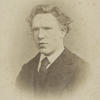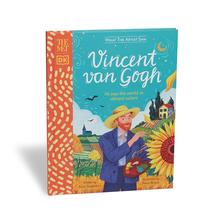More about Starry Night Over the Rhône
- All
- Info
- Shop

Contributor
Van Gogh's Starry Night Over the Rhône is arguably more beautiful his other cult classic Starry Night.
So why isn't this one plastered all over novelty notebooks and coffee mugs?
Starry Night Over the Rhône was one of the last paintings that Van Gogh created during his happy years, although I’m not sure if “happy” and “Van Gogh” have been used in the same sentence since the whole cutting off the ear and delivering it to a prostitute fiasco.
He painted it while sitting on the banks of the idyllic Rhône river in the French city of Arles, where he represented the night sky under rays of light shed from lit candles that were apparently―in a dazzling feat of impeccable posture―resting on the brim of his hat. The second Starry Night, (which he actually considered to be an absolute failure) was created from inside the barred windows of an asylum. Van Gogh would need to piece the scene together from memory, as he was no longer able to roam the banks of the Rhône under the moonlight. Or anywhere else for that matter.
Van Gogh painted Starry Night Over the Rhône in 1888, which was the same year that he had the brilliant idea to abandon all responsibilities and run away to establish an artist community in the Yellow House in Arles. You’ve got to hand it to the guy for trying, it's a nice sentiment. But alas, like that one friend that plans too many parties that no one really wants to go to, Van Gogh ended up in Arles alone. Well, not alone persay. Gauguin came. But he probably would have been better off alone.
Regardless, this was a time of fervent exploration for Van Gogh that inspired him to finally paint the sky at night―a goal that he had been dreaming of for quite some time. He described it in a letter to his brother Theo in 1988: “The starry sky at last, actually painted at night, under a gas-lamp. The sky is green-blue, the water is royal blue, the areas of land are mauve. The town is blue and violet. The gaslight is yellow, and its reflections are red gold and go right down to green bronze.” What sounds like a description of his new paint-by-numbers set became one of the most ethereal paintings in existence today.
He didn't portray everything true to nature―unless you consider Dahlia inspired stars realistic―but he did get some qualities spot-on: the Big Dipper and North Star are easily discernable. Well, to NASA at least. I'm not so adept at recognizing constellations. Sorry, Van Gogh.
Sources
- "Letter from Vincent van Gogh to Theo van Gogh Arles, 28 September 1888." Vincent van Gogh to Theo van Gogh : 28 September 1888. Accessed October 01, 2017. http://www.webexhibits.org/vangogh/letter/18/543.htm.
- Pickvance, Ronald. Van Gogh in Saint-Rémy and Auvers. New York, NY: The Metropolitan Museum of Art, 1987. 103-107
- Schaefer , B. “Astronomy Picture of the Day.” NASA, NASA, 21 Sept. 2010, apod.nasa.gov/apod/ap100921.html.
- Schaefer , B. “Astronomy Picture of the Day.” NASA, NASA, 21 Sept. 2010, apod.nasa.gov/apod/ap100921.html.


















